The Hun Bow
Hun Bow
The Hun bow consisted of a combination of materials – horn on the inside, or belly of the bow, sinew on the back, and a wooden core. The materials were held together with fish bladder or hide glue. Bows discovered in tombs and graves attributed to the Huns reveal the importance of the weapon to these and other nomads from the Eurasian Steppe. The Hun bow is approximately 55 inches in length and contains thin bone plaques on the siyahs and the handle or riser. The image below shows its asymmetrical shape, with the upper limb slightly longer than the lower.
CLICK HERE TO BUY A HUN BOW!
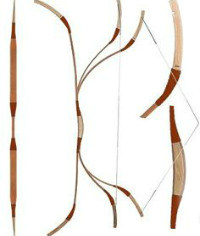
Hun Archery
A thumb ring was likely used when releasing a Hunnic bow. The asymmetrical design made for a more effective and accurate shot using a thumb draw. A technique may have been employed where the bow was whipped forward and slightly downwards as the archery released his shot. The addition of horn plates to the siyahs or ears of the bow make it more rigid and add extra leverage to the shot. The traditional Magyar bow also has horn plates on the siyahs. In addition to the recurve bow, scholars today credit the Huns with the introduction of the stirrup into Western Europe. With this innovation, the Hunnic warrior could “stand” in his saddle and freely turn as he released deadly arrows upon his enemies.
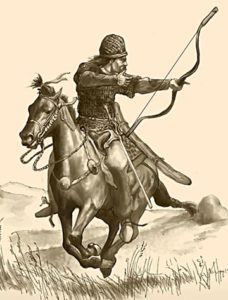
Arrival of the Hun
The Huns valued mastery of both the horse and the bow. The primary reason for their military successes proved their mastery of mounted archery and their bow, a weapon more powerful than that of the Romans and in fact later copied by their rivals. The vast expanse of grasslands that stretched from China to Hungary, called the Steppes, affected the history of the world. Countless migratory tribes traveled this area and came into contact with established civilizations, such as the Chinese and Roman Empires, in both friendly and hostile confrontations.
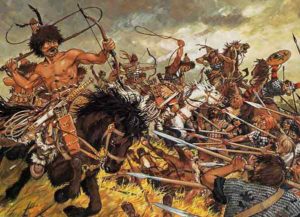
The Huns wrought havoc as they traveled East to West, which eventually led to the demise of the Western Roman Empire. Harsh life on the Steppes hardened the groups who survived in this world of constant warfare. Europe especially feared the Huns because this nomadic group menaced and nearly destroyed the ancient city of Rome. The ferocity and swiftness of the Huns’ initial raids into Western Europe left the unprepared continent reeling. A Christian prayer expressed Europe’s terror of this group – A sagittis Hunorum, nos defende, Domine (From the arrows of the Huns, O Lord, defend us.)
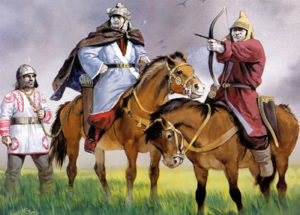
The Huns fostered a military society. Children learned to ride a horse before they walked and newborns were ritualistically scarred on their faces to learn to bear pain before anything else, even mother’s milk. The Huns also practiced head binding, a procedure applied to the pliable skulls of infants through pressure with a cloth or other implement. A male Hun became an accomplished mounted archer well before he reached manhood.
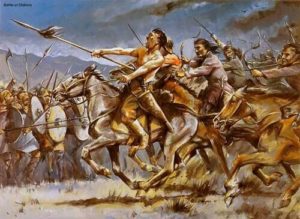
The Huns left no written records and thus their origin remains unknown. Most of our information about the Huns comes from their enemies and conveys an obvious bias. Scholars today agree that the Huns originated in Central Asia, which supports an ancient legend that the Chinese built the Great Wall to prevent the Huns from invading their heartland. Renowned French orientalist and sinologist Joseph de Guignes (1721-1800) suggested that the Hunnish tribe that attacked Rome in the fifth century AD was the same that defeated and expelled by the Chinese Han dynasty around 89 AD, which showed an extensive history and geography of military incursions.

Attila the Hun
Under their legendary leader Attila, the Huns eventually settled in the Danube Valley in modern-day Hungary, where they reached their peak as a unified state. The Huns left no written records, so most of what we know of them and their ruler Attila comes to us from their enemies, who would have possibly viewed the Huns in a negative light. The most noteworthy secondary source on Attila and the Huns comes to us from Jordanes, a was a 6th-century Roman bureaucrat and historian, who cites the first hand account of Priscus, who had accompanied Maximus, the head of the Byzantine embassy representing Emperor Theodosius II, on a diplomatic mission to the court of Attila the Hun.

Meeting Attila
Jordanes gives a second-hand account of Priscus describing an encounter with Attila in 449 A.D.:
“He was a man born into the world to shake the nations, the scourge of all lands, who in some way terrified all mankind by the dreadful rumors noised abroad concerning him. He was haughty in his walk, rolling his eyes hither and thither so that the power of his proud spirit appeared in the movement of his body. He was indeed a lover of war, yet restrained in action, mighty in counsel, gracious to suppliants and lenient to those who were once received into his protection. Short of stature, with a broad chest and a large head; his eyes were small, his beard thin and sprinkled with grey; and he had a flat nose and tanned skin, showing evidence of his origin.”
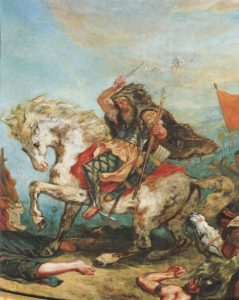
Rise to Power
Born sometime around 405 A.D., Attila would be renowned in the history books for his brutal invasions of the civilized world, almost bringing the mighty Roman Empire to its knees. Attila and his brother Bleda were apparently in the care of their uncle Ruga, a minor Hun chief after their parents had died. Young Attila grew up in a time of great change for his people, who were traditionally nomadic pastoralists, migrating through the vast steppes of Eurasia, but were now coming into contact with the sedentary peoples of Western Europe. As the Hun’s pressed ever westward, other barbarian tribes on Rome’s frontiers were scattered and forced into Roman territory, seeking protection from the new menace from the East.
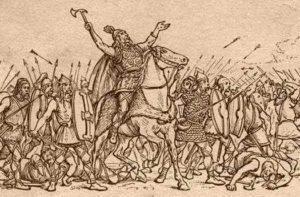
The death of Ruga (also known as Rugila or Ruga) in 434 left his nephew, Attila and his older brother Bleda, in control of the united Hun tribes. Attila and Bleda negotiated a treaty with the Romans, who would double their previous tribute of 350 Roman pounds of gold. The Huns remained out of Roman sight for the next few years while an attempt was made to invade the Sassanid Empire. After a defeat in Armenia, Attila and Bleda abandoned their invasion, and turned their attentions back to Europe. They would appear again in force on the borders of the Roman Empire in 440, attacking the merchants at the market on the north bank of the Danube that had been established by the treaty. Attila and Bleda would go on to ravage the Balkans until Emporer Theodosius admitted defeat and sued for peace.
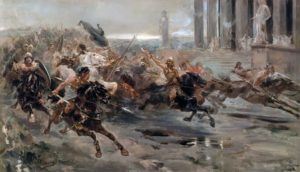
The terms were harsher than the previous treaty: the Emperor agreed to hand over 6,000 Roman pounds (c. 2000 kg) of gold as punishment for having disobeyed the terms of the treaty during the invasion; the yearly tribute was tripled, rising to 2,100 Roman pounds in gold.
Satisfied the Hun kings withdrew into the interior of their empire. Bleda died following the Huns’ withdrawal from Byzantium (circa 445). Attila would take the throne as the sole ruler of all Huns and subjugated tribes.
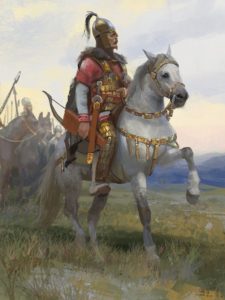
After about 450 A.D. Attila would march largely unopposed through the Balkans and most of Western Europe, sacking city after city. He was finally checked at the infamous Battle of the Catalaunian Plains in 451 by a coalition of forces mustered by the Roman General Flavius Aetius, who was well aware of Hunnish warfare, spending some of his childhood as a hostage among the Huns. Although the victory for the Romans was not decisive, Attila would march back west towards his base in Hungary, pillaging and destroying many of the towns and cities down the Italian peninsula.
Attila would return to Hungary and take another wife (Attila had many) in 453 A.D. He would die on his wedding night under suspicious circumstances. It is widely believed he died of a nosebleed in a drunken stupor, but some would consider the possibility of him being assassinated.
Hun Bow for Sale, by Jackal Archery, Click Image
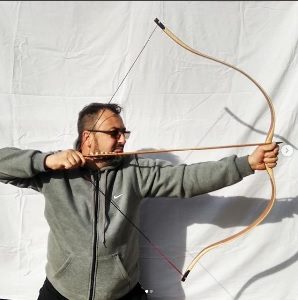
CLICK HERE FOR BOOKS